Posters presented at Transportation Research Board
Walter E. Washington Convention Center. Washington DC, USA
January 8–12, 2017
|
Sai Chand
Co-Author(s): Gregory Aouad, Vinayak Dixit
Title:
Long-range dependence of traffic flow and speed of a Motorway: dynamics and correlation with historical Incidents.
Abstract: Speed and flow of vehicles tend to have several effects on the dynamics of a transport system. Fluctuations of these variables can implicate congestion, lower predictability and may even catalyze crashes. This paper utilizes a concept of fractal theory called the Hurst exponent, a measure of the long-range dependence (LRD) of a time-series to understand the fluctuations in flow and speed of a motorway in Sydney, Australia. The spatial and temporal variation of LRD for flow (Hflow) and speed (Hspeed) at several monitor sites were discussed. Furthermore, the effects of number of lanes on flow and speed predictability were also explored. It was observed that the flow predictability of 2-lane sections is significantly lower when compared with 3-lane and 4-lane sections. Conversely, the speed predictability of 4-lane sections is significantly higher than 2-lane and 3-lane sections. Finally, traffic congestion was defined in terms of LRD of speed and its correlation to historical incident rates was measured. It was ascertained that monitor sites with a historically high proportion of large Hspeed, were correlated with unsafe locations. It is anticipated this study would lead to many applications of fractal analysis on highways and urban traffic.
|
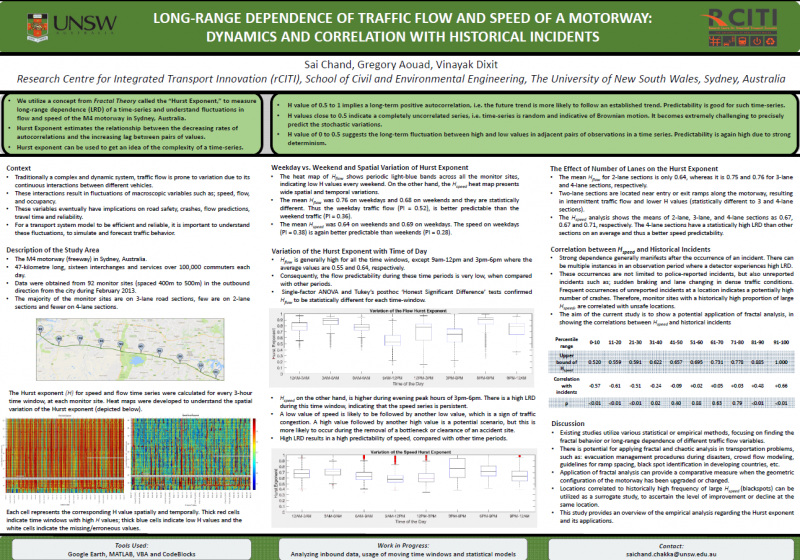 |
Hanna Grzybowska
Co-Author(s): Daniel Guimarans
Title: Real-Time Field Service Engineer Scheduling Problem with Emergencies and Collaborations – a Simulation–Optimization Approach.
Abstract: We address the real-time Field Service Engineer (FSE) routing and scheduling problem encountered in human resources operations. For many companies the assignment of FSEs to jobs is challenging due to the dynamic occurrence of job requests. This adds up to contractual conditions generally imposing hard service time windows (TW) and high service standards, e.g. maximum response time to an emergency. The problem also includes further constraints defining: (i) collaborations between the FSEs (if needed), and (ii) different levels of jobs’ emergency (the higher the job emergency, the faster reaction is required). An additional factor, usually neglected, which needs to be considered is the comfort of the FSEs regarding the route stability. To account for this aspect we propose a novel methodological approach that aims at mitigating the disruption propagation in addition to the minimization of the operational cost - i.e. if a FSE is not assigned to an emergency, his planning should not change, or suffer minimal deviations if close to the emergency location. To solve the problem, we designed an event-driven simulation-based optimization approach using Large Neighborhood Search. This research is a result of a commercial engagement with industry and provides results for the real-life inspired scenarios.
|
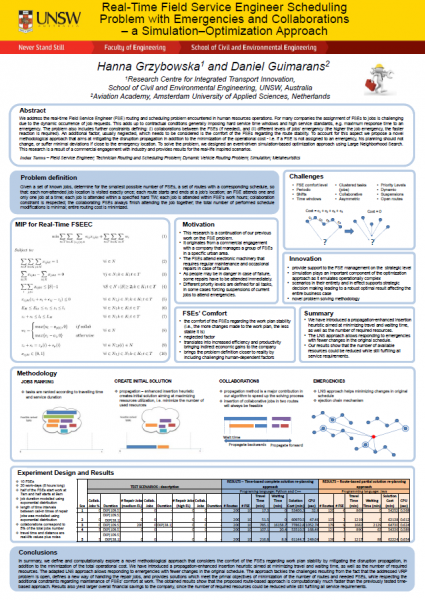 |
Chenyang Li
Co-Author(s): Vinayak Dixit.
Title: Estimating The Subjective Risks In Car Following
Abstract: Decision-making theory enables us to consider the car-following behaviour from a behavioural perspective. The aim of this study is to propose a behavioural car-following model incorporating risk attitude and risk perception based on the subjective expected utility (SEU) theory. Risk perception is related to the subjective probability of getting involved in a rear-end collision that is dependent on the space headway perceived by drivers. To demonstrate the validity of the proposed car-following model, the steady-state condition is also considered. In the proposed car-following model, the coefficients of risk attitude, standard deviation of the perceived space headway and vehicle weight are estimated using the Next-Generation Simulation (NGSIM) vehicle trajectory data. The steady-state model is estimated using the Next-Generation Simulation (NGSIM) loop detector data. It is notable that the estimates of the proposed car-following model are consistent with the estimation results of the steady-state model. This study analyses the car-following behaviour in four situations: 1) a car follows a car, 2) a car follows a truck, 3) a truck follows a car and 4) a truck follows a truck. An important finding of this study is that drivers are risk averse in these four car-following conditions. This is consistent with the finding from laboratory experiments by Vinayak et al. (1). Furthermore, truck drivers while following a car have the relatively high standard deviation of the perceived space headway, which implies that truck drivers are more prone to make the erroneous perception of space headway when following a car.
|
|
Edward Robson
Co-Author(s): Vinayak Dixit.
Title: Constructing A Database For Computable General Equilibrium Modelling Of The Sydney Transport Network
Abstract: In the search for benefits to justify transport projects, economic appraisals have increasingly incorporated the valuation of impacts to the wider economy. Computable general equilibrium (CGE) models provide a framework to estimate these impacts by simulating the interactions of urban economies and transport networks. In CGE models, households and firms are represented with microeconomic behavioural functions and markets adjust according to prices. As markets both within and outside the transport network are taken into account, a wide variety of measures which can assist in economic appraisals can be extracted. However, urban CGE models are computationally burdensome and require detailed, spatially disaggregate data. This paper discusses the methodology used to develop a database, including an input–output table, for the calibration of an urban CGE model for Sydney, Australia. Official and publicly available data sources were manipulated using a number of mathematical and statistical techniques to compile the table for 249 regions and 20 sectors across Sydney. Issues that other input–output table developers may encounter when constructing multiregional tables were addressed in the study, such as determining the appropriate level of disaggregation, generating incomplete data and managing conflicting data. The table entries themselves were mapped and explored as they provide an interesting study of the spatial economy of Sydney. Future work will focus on streamlining the construction of input–output tables and incorporating new data sources.
|
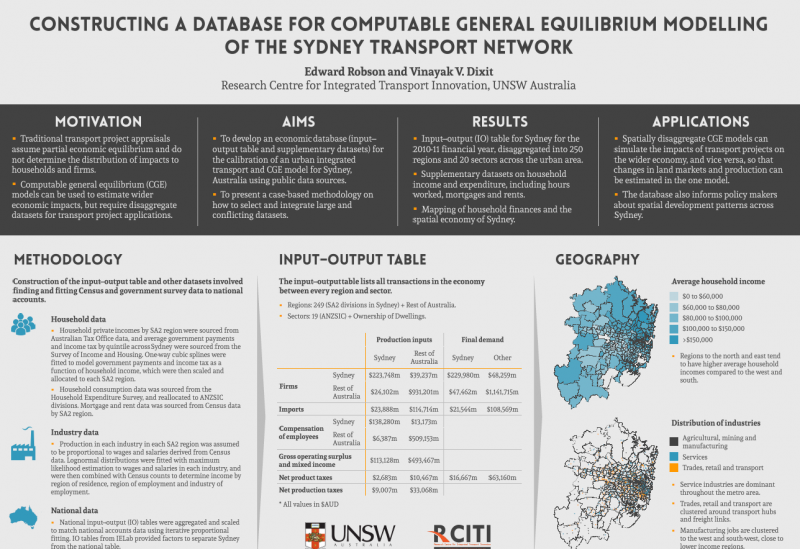 |
Neeraj Saxena
Co-Author(s): Taha H Rashidi, Vinayak Dixit, S. Travis Waller.
Title: Influence Of Number Of Stop-&-Gos On The Route Choice Behavior 1 Of Car Drivers In Urban Road Networks
Abstract: Stop-&-go (S&G) waves are prevalent in congested traffic conditions and are characterized by cyclic patterns of forced deceleration followed by acceleration. These cause increased fuel emissions, safety risks and also impact driver’s physiology. Due to its frequent and annoying nature, drivers tend to avoid traveling on routes with more occurrences of S&G waves. Past studies have shown that route choice is often influenced by the amount of time spent in S&G traffic. However, this attribute is not a good proxy to discomfort when compared to the number of S&Gs experienced. The objective of this study was to test the hypothesis: an increase in the number of stop-&-gos on a route increases its disutility. A stated choice experiment was conducted to study the route choice behavior of respondents who drove regularly to university campus by car. A status quo random parameter logit (SQ-RPL) model was used for analysis to account for the preference heterogeneity among individuals and the correlation across multiple choice tasks due to the presence of a status quo alternative. Results indicated an increased disutility on routes with larger number of S&Gs, which validated the hypothesis proposed in this study. The study also found that drivers, on average, were willing to travel for additional 16 seconds to reduce the occurrence of S&G by one on their traveled route. This study mainly contributes towards developing models that can inform current traffic assignment models to account for an impact of the number of S&Gs on route choice.
|
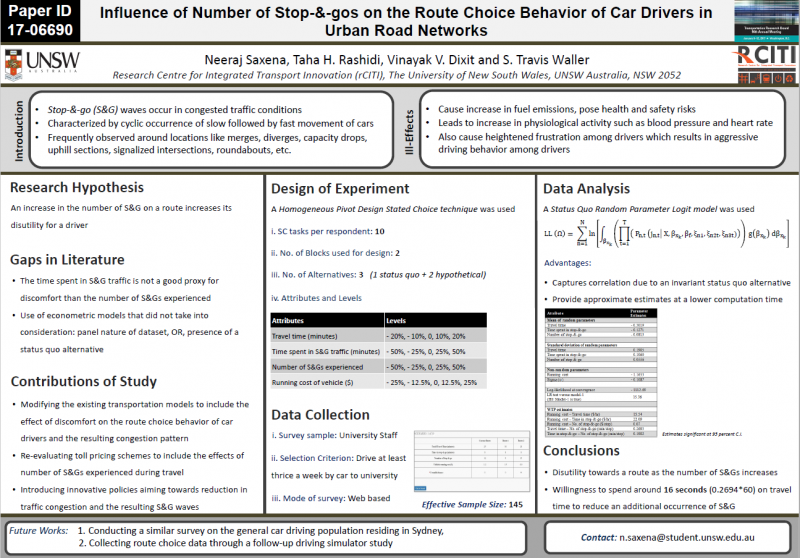 |
Neeraj Saxena
Co-Author(s): Vinayak Dixit, S. Travis Waller.
Title: Consistency Between Convergence Of Dynamic Assignment And Stochasticity Of Microsimulation: Implication On The Number Of Runs.
Abstract: Dynamic transportation models route vehicles using the principles of dynamic user equilibrium (DUE). These models include a dynamic network loading (DNL) module which is used to evaluate link costs. However, an element of stochasticity creeps into the modelling framework when the analytical dynamic assignment (DA) procedure is used along with a stochastic microscopic DNL. A methodologically correct way of solving this problem is through solving the entire DA with a microscopic DNL (DA-MicroDNL) model until convergence for a given random seed, and then repeating the process with different seed values. This study proposes an approach to determine the minimum number of replications of the DA-MicroDNL model to determine a statistically valid estimate of the measure of effectiveness (MoE). The approach was tested on a small and medium sized network having different demand and network characteristics. Results show that running the integrated DA-MicroDNL framework for a minimum number of replications provides a statistically significant MoE at much lower computation time. The consistent estimates obtained using this approach would provide robust information to transportation planners and practitioners in evaluating the impacts of several policy decisions on network performance.
|
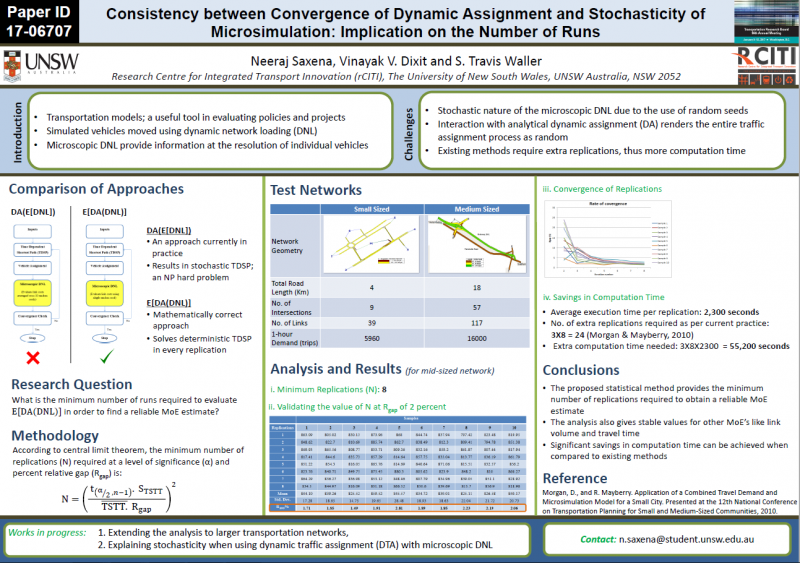 |
Kasun P. Wijayaratna
Co-Author(s): Vinayak Dixit, Laurent Denant-Boemaont, S. Travis Waller.
Title: Does en-route information improve road network performance? An experimental study of the online information paradox
Abstract: This study investigates the empirical presence of a theoretical transportation paradox, defined as the “Online Information Paradox” (OIP). The paradox suggests that the provision of online information deteriorates trip conditions for the entire network relative to the scenario where information is not provided to users. The analytical presence of the paradox was derived for the specific network structure by using two equilibrium models, the first being the Expected User Equilibrium (EUE) solution (no information) and the other being the User Equilibrium with Recourse (UER) solution (with information). A laboratory economic experiment is used to involve an incentivized computerized route choice game that investigates the physical presence of the paradox.
Aggregate statistics of path flows and Total System Travel Cost (TSTC) were used to compare the experimental results with the theoretical findings. A total of 12 groups of 12 participants completed the experiment and the OIP was observed in 11 of the 12 cases, its occurrence being highly significant. Though information increased travel costs for users on average, it reduced the volatility of Travel costs experienced in the no information scenario indicating that information can achieve a more reliable system. Further replications of such experiments and more importantly field based identification of the phenomena will force transport professionals to not only be aware of the emergence of the paradox but also emphasize the need for the adoption of adaptive traffic assignment techniques such as UER to appropriately model the acquisition of information on a road network.
|
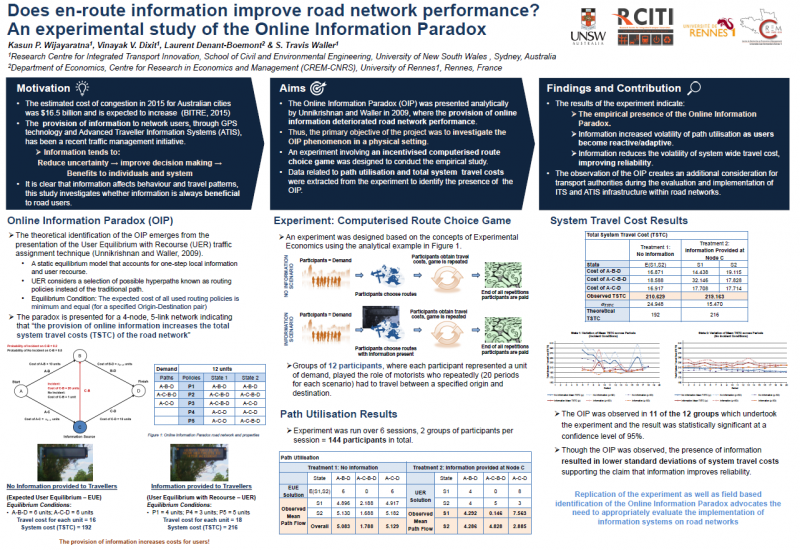 |
|
|
Xiang Zhang
Co-Authors: S. Travis Waller, David Rey, Nathan Chen, David Rey
Title: Aggregated Transportation Network Design Problem Considering Electric Vehicle Recharge Facility Allocation.
Abstract:
This study addresses the transportation network design problem (NDP) wherein the distance limit and en-route recharge of electric vehicles are taken into account. Specifically, in this work, the network design problem aims to select the optimal planning policy from a set of infrastructure design scenarios considering both road expansions and charging station allocations under a specified construction budget. The user-equilibrium mixed-vehicular traffic assignment problem with en-route recharge (MVTAP-ER) is formulated into a novel convex optimization model and extended to a newly developed bi-level program of the aggregated NDP integrating recharge facility allocation (NDP-RFA). In the algorithmic framework, a convex optimization technique and a tailored GA are adopted for, respectively, solving the subproblem – MVTAP-ER and the primal problem – NDP-RFA. Systematic experiments are conducted to test the efficacy of the proposed approaches. The results highlight the impacts of distance limits and budget levels on the project selection and evaluation. The results also report that the two design objectives, to respectively minimize the total system travel time and vehicle miles travelled, are conflicting for certain scenarios.
|
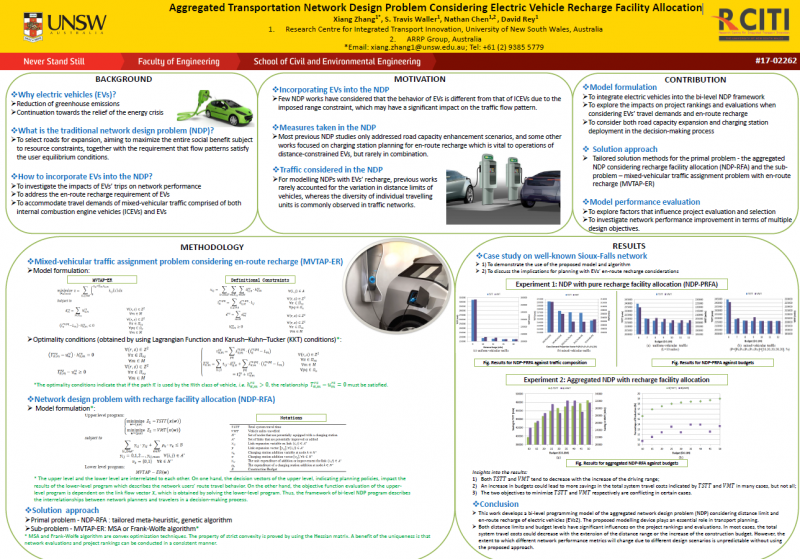 |
Xiang Zhang
Co-Authors: S. Travis Waller, David Rey, Melissa Duell.
Title: Integrating Uncertainty Considerations into the 1 Sustainable Transportation Network Design
Abstract: Few previous works integrated both uncertainty and environment disruption into the traffic network design problem (NDP), despite the critical impact of these two factors in sustainable transportation planning. This study aims to address this gap. First, the mathematical framework of the strategic user equilibrium (StrUE) traffic assignment under volatility of both total travel demand and link capacity is analyzed, which reflects disequilibrium observed in traffic networks. Second, we incorporate the StrUE traffic assignment model into a network design project and propose a multiobjective bi-level program for the sustainable NDP. Two objective functions are formulated, which are respectively to minimize the expected total system travel time and minimize the expected total system off-gas emissions in the uncertainty-based NDP. Third, in the algorithmic framework, we develop two tailored solution methods – one is an exact algorithm and the other one is a metaheuristic method based on a genetic algorithm. Finally, systematic evaluation of the performance of the proposed approach is conducted on three different test networks. The results highlight that ignoring uncertainty considerations can result in sub-optimal design solutions in terms of expected network performance in long-term transportation planning decisions. The results also report that the two objectives, to minimize system-level travel time and vehicle emission, are conflicting for certain uncertainty-based design scenarios.
|
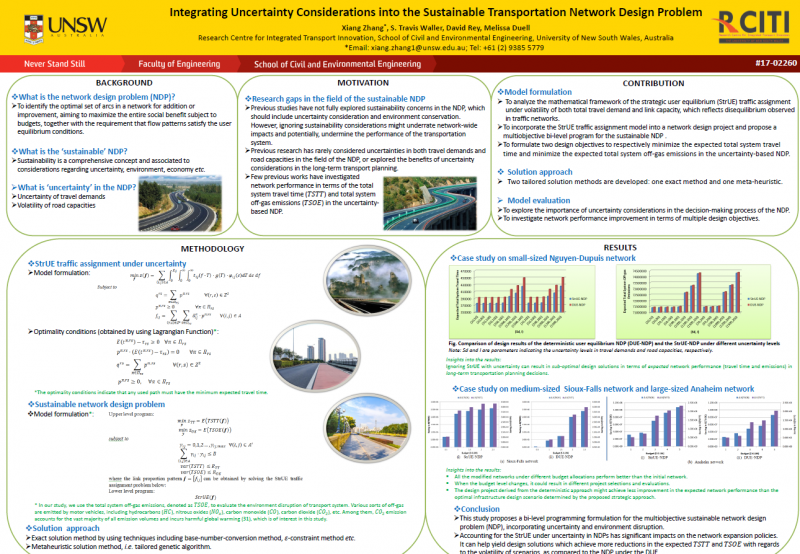 |